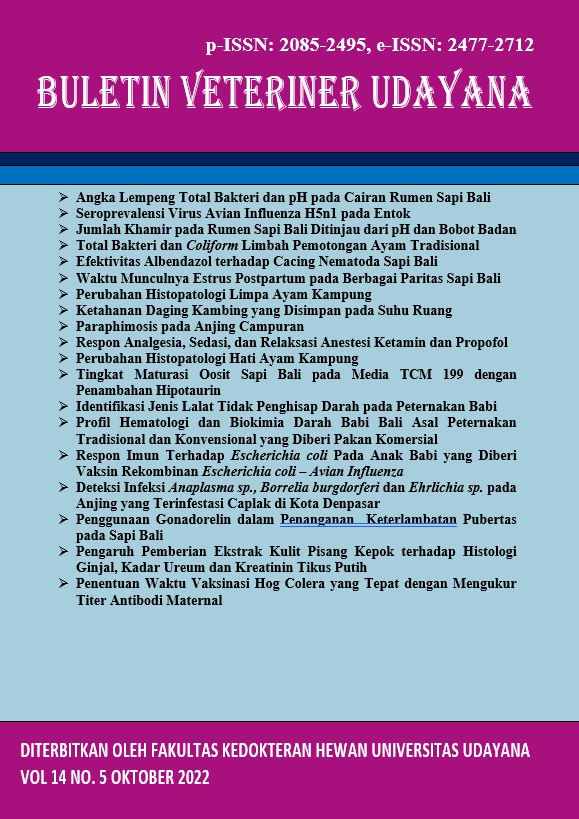BLOOD HEMATOLOGICAL AND BIOCHEMICAL PROFILE OF BALI PIGS FROM TRADITIONAL AND CONVENTIONAL FARM SUPPLEMENTED WITH COMMERCIALLY MEAL
Abstract
Experimental studies have been carried out to determine the weight gain, blood hematological and biochemical profile of weaning bali pig from traditional and conventional farms which are then given the same treatment as commercial feed. Weighing pigs is carried out every two weeks for two months. Examination of blood samples was carried out three times, at the beginning, middle and end of the study. The hematology profile was examined with a hematology analyzer. Cholesterol, triglycerides, and protein total were examined by photometer. The results showed that the weight gain of weaning pigs from traditional and conventional farms for 8 weeks was 13.81 kg and 14.19 kg (P>0.05). Overall range of erythrocytes; hematocrit; and hemoglobin in this study were 7.47-8.59 x 106/µL; 37.23-44.78 %; and 11.95-14.17 g/dL, respectively. The total leukocyte range is 19.12-28.18 x 103/µL; neutrophils: 0.49-7.19 %; eosinophils: 0.24-2.0 %; basophils: 0.73-5.18 %; lymphocytes: 16.22-83.02 %; and monocytes 1.21-6.82 %. The cholesterol range is 65.85-90.00 mg/dL; triglycerides: 30,75-78,81 mg/dL; and protein total: 5.0-6.6 g/dL. There was no statistically significant difference (P>0.05) between the average erythrocytes, hematocrit, hemoglobin, leukocytes total, leukocytes differential, cholesterol and protein total of piglets originating from traditional farm compared to those from conventional farm. However, there were significant differences (P<0.05) in triglyceride levels.
Downloads
References
Budaarsa K, Puger AW, Suasta IM. 2016. Eksplorasi komposisi pakan babi tradisional babi bali. Maj. Ilmiah Peternakan. 19(1): 6-11.
Cases-Diaz E, Closa-Sebastia F, Ignasi M, Lavin S, Bach-Raich E, Cuenca R. 2015. Hematologic and biochemical reference intervals for wild boar (Sus scrofa) captured by cage trap. Vet. Clin. Pathol. 44(2): 215–222.
Collins CL, Pluske JR, Morrison RS, McDonald TN, Smits RJ, Henman DJ, Stensland I, Dunshea FR. 2017. Post-weaning and whole-of-life performance of pigs is determined by live weight at weaning and the complexity of the diet fed after weaning. Anim. Nutr. 3: 372-379.
Cooper AC, Moraes LE, Murray JD, Owens SD. 2014. Hematologic and biochemical reference intervals for specific pathogen free 6-week-old hampshire-yorkshire crossbred pigs. J. Anim. Sci. Biotechnol. 5:5. doi: 10.1186/2049-1891-5-5.
Dharmawan NS. 2002. Pengantar Patologi Klinik Veteriner Hematologi Klinik. Penerbit Universitas Udayana. Kampus Bukit Jimbaran.
Estienne MJ, ClarkDeener SG, Williams KA. 2019. Growth performance and hematology characteristics in pigs treated with iron at birth and weaning and fed a nursery diet supplemented with a pharmacological level of zinc oxide. J. Swine Health Prod. 27(2): 6475.
Etim NN, Williams ME, Akpabio U, Offiong EEA. 2014. Haematological parameters and factors affecting their values. Agric. Sci. 2(1): 37-47.
Fielder SE. 2020. Hematologic Reference Ranges. MSD and the MSD Veterinary Manual. https://www.msdvetmanual.com/special-subjects/reference-guides/hematologic-reference-ranges. [30-05-2020 5:48 AM].
Huang Y, Olson DJ, Gordon JR, Middleton DM, Simko E. 2012. Plasma protein profiles of neonatal pigs before and after suckling. Can. J. Vet. Res. 76: 1-7.
Jaya SKGA, Budaarsa K, Mahardika IG. 2019. Performa babi bali yang dipelihara dalam kandang dengan alas kandang tanah, beton, dan litter (Bapuk). Maj. Ilmiah Peternakan. 22(1): 10-16.
Jezek J, Staric J, Nemec M, Plut J, Oven IG, Klinkon M, Sturkelj M. 2018. The influence of age, farm, and physiological status on pig hematological profiles. J. Swine Health Prod. 26(2): 72-78.
Jim EL. 2013. Metabolisme lipoprotein. J. Biomedik. 5(3): 149-156.
Kalita G, Buragohain R, Saikia P, Sarma K, Rahman S. 2015. Effect of weaning age on growth performance and feed conversion efficiency of large white yorkshire (lwy) piglets under intensive system of management in mizoram. IJSRST. 1(4): 90-94.
Klem TB, Bleken E, Morberg H, Thoresen SI, Framstad T. 2010. Hematologic and biochemical reference intervals for norwegian crossbreed grower pigs. Vet. Clin. Pathol. (2): 221-226.
Leliveld LMC, Riemensperger AV, Gardiner GE, O'Doherty JV, Lynch PB, Lawlor PG. 2013. Effect of weaning age and postweaning feeding programme on the growth performance of pigs to 10 weeks of age. Livestock Sci. 157(1): 225-233.
López-Vergé S, Gasa J, Temple D, Bonet J, Coma J, Solà-Orio D. 2018. Strategies to improve the growth and homogeneity of growing-finishing pigs: feeder space and feeding management. Porcine Health Manag. 4: 14.
Mayer DJ, Harvey JW. 2004. Veterinary Laboratory Medicine: Interpretation and Diagnosis. 3rd Ed. Saunders, Philadelphia.
Merdana IM, Sudira IW, Putra GYD. 2019. Pertambahan bobot badan anak babi persilangan jantan periode nurserry setelah pemberian enzim pencernaan dan tepung kunyit. Bul. Vet. Udayana. 11(2): 212-219.
Mungate F, Dzama K, Mandisodza K, Shoniwa A. 1999. Some non-genetic factors affecting commercial pig production in Zimbabwe. South Africa J. Anim. Sci. 29: 164-173.
Paramita KS, Mahardika IG, Dharmawan NS. 2016. Total dan diferensial leukosit babi landrace yang diberi pakan eceng gondok (Eichornia crassipes) dari perairan tercemar timbal (Pb). Bul. Vet. Udayana. 8(2): 166-171.
Putri PVC, Budaarsa K, Dharmawan NS. 2017. Total eritrosit, kadar hemoglobin, dan nilai hematokrit babi landrace yang diberi pakan eceng gondok dari perairan tercemar timbal. Bul. Vet. Udayana. 9(1): 67-72.
Sihombing DTH 1997. Ilmu Ternak Babi. Gadjah Mada University Press. Yogyakarta.
Sinaga S, Sihombing DTH, Kartiarso, Bintang M. 2011. Kurkumin dalam ransum babi sebagai pengganti antibiotik sintetis untuk perangsang pertumbuhan. J. Ilmu-ilmu Hayati dan Fisik. 13(2): 125-132.
Suarjana IGK, Besung NK, Rompis ALT, Gelgel KTP. 2020. Pengobatan penyakit pernapasan pada babi dalam upaya meningkatkan produktivitas ternak di Desa Penarukan, Kerambitan, Tabanan. Bul. Vet. Udayana. 12(1): 55-60.
Utama IPSY, Sumadi IK, Suasta IM. 2016. Pengaruh imbangan energi dan protein ransum terhadap pertumbuhan babi bali jantan lepas sapih. J. Peternakan Trop. 4(3): 519-528.
Weiss DJ, Wardrop KJ. 2010. Schalm’s Veterinary Hematology. 6th Ed. Blackwell Publishing Ltd. Iowa.
Yeom SC, Cho SY, Park CG, Lee WJ. 2012. Analysis of reference interval and age-related in serum biochemistry and hematology in the specific pathogen free miniature pig. Lab. Anim. Res. 28(4): 245-253.
Yu K, Canalias F, Sola-Oriol D, Arryo L, Pato R, Saco Y, Terre M, Bassols A 2019. Age-related serum biochemical reference interval established for unweaned calves and piglets in the post-weaning period. Front. Vet. Sci. 6: 123.





